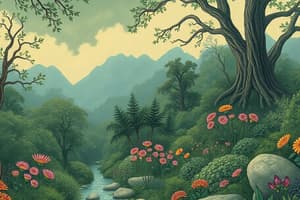Podcast
Questions and Answers
Which classification level comes directly after the family level in biological classification?
Which classification level comes directly after the family level in biological classification?
- Genus (correct)
- Phylum
- Species
- Order
What is a primary function of the circulatory system in human biology?
What is a primary function of the circulatory system in human biology?
- Transporting hormones and nutrients (correct)
- Producing energy
- Nutrient absorption
- Gas exchange
Which of the following describes the principle mechanism of natural selection?
Which of the following describes the principle mechanism of natural selection?
- Random mutations lead to diversity.
- All organisms adapt equally over generations.
- Environmental changes create new species immediately.
- Survival of the fittest determines reproductive success. (correct)
In hypothesis testing, which step directly follows experimentation?
In hypothesis testing, which step directly follows experimentation?
What ethical consideration is particularly relevant in genetic engineering?
What ethical consideration is particularly relevant in genetic engineering?
Which of the following describes the main difference between a food chain and a food web?
Which of the following describes the main difference between a food chain and a food web?
What is a primary characteristic of biomes?
What is a primary characteristic of biomes?
Which of the following processes directly results in the synthesis of proteins?
Which of the following processes directly results in the synthesis of proteins?
What is the focus of conservation biology?
What is the focus of conservation biology?
Which of the following best differentiates aerobic respiration from anaerobic respiration?
Which of the following best differentiates aerobic respiration from anaerobic respiration?
Flashcards are hidden until you start studying
Study Notes
Ecology
- Definition: Study of interactions between organisms and their environment.
- Ecosystems: Composed of biotic (living) and abiotic (non-living) components.
- Biomes: Large ecological areas with distinct climates, vegetation, and wildlife (e.g., tundra, desert, rainforest).
- Food Chains and Webs:
- Food Chain: Linear sequence of energy transfer (e.g., producer → herbivore → carnivore).
- Food Web: Interconnected food chains showing multiple feeding relationships.
- Biogeochemical Cycles:
- Water Cycle: Involves evaporation, condensation, precipitation, and infiltration.
- Carbon Cycle: Movement of carbon through the atmosphere, organisms, and Earth.
- Nitrogen Cycle: Conversion of nitrogen among its various chemical forms.
- Population Dynamics: Study of factors affecting population size and growth (e.g., birth/death rates, immigration/emigration).
- Ecological Succession: Process of change in species composition over time, including primary and secondary succession.
- Conservation Biology: Focus on protecting biodiversity and ecosystems from threats like habitat destruction and pollution.
Molecular Biology
- Definition: Study of biological processes at the molecular level.
- Key Concepts:
- DNA Structure: Double helix composed of nucleotides (adenine, thymine, cytosine, guanine).
- RNA: Single-stranded molecule involved in protein synthesis (mRNA, tRNA, rRNA).
- Protein Synthesis:
- Transcription: Process of converting DNA to mRNA.
- Translation: Synthesis of proteins from mRNA by ribosomes.
- Enzymes: Biological catalysts that speed up chemical reactions; affected by temperature, pH, and substrate concentration.
- Cellular Respiration: Process by which cells convert glucose and oxygen into energy (ATP), carbon dioxide, and water.
- Aerobic vs. Anaerobic respiration.
- Cell Cycle: Series of phases that cells go through for growth and division (interphase, mitosis, cytokinesis).
- Genetic Engineering: Manipulation of an organism's DNA using biotechnology techniques (e.g., CRISPR, recombinant DNA technology).
General Awareness
- Biological Classification: Organisms are classified into a hierarchy (domain, kingdom, phylum, class, order, family, genus, species).
- Basic Cell Types:
- Prokaryotic: Simple, no nucleus (e.g., bacteria).
- Eukaryotic: Complex, with nucleus (e.g., plants, animals, fungi).
- Key Figures in Biology: Charles Darwin (evolution), Gregor Mendel (genetics), Louis Pasteur (microbiology).
- Principles of Evolution: Natural selection, adaptation, speciation.
- Human Biology: Overview of major systems (circulatory, respiratory, digestive, nervous) and their functions.
Reasoning
- Scientific Method: Steps include observation, hypothesis formation, experimentation, analysis, and conclusion.
- Critical Thinking: Evaluating information and arguments logically, recognizing biases and assumptions.
- Hypothesis Testing: The importance of controlled experiments and statistical analysis in validating hypotheses.
- Data Interpretation: Ability to analyze graphs, charts, and data sets to draw conclusions.
- Ethics in Biology: Discussion of ethical considerations in research, including animal testing and genetic manipulation.
Ecology
- Study of interactions between organisms and their environment.
- Ecosystems consist of biotic (living) and abiotic (non-living) components that interact to form complex relationships.
- Biomes are large ecological areas characterized by distinct climates, vegetation types, and wildlife, including tundra, desert, and rainforest.
- Food Chain illustrates a linear energy transfer sequence: producer → herbivore → carnivore.
- Food Web showcases interconnected food chains, highlighting various feeding relationships within an ecosystem.
- Biogeochemical Cycles include:
- Water Cycle: Processes of evaporation, condensation, precipitation, and infiltration.
- Carbon Cycle: Movement of carbon through the atmosphere, living organisms, and Earth's surface.
- Nitrogen Cycle: Transformation of nitrogen among different chemical forms in the ecosystem.
- Population Dynamics focuses on factors influencing population size such as birth/death rates and migration patterns.
- Ecological Succession describes changes in species composition over time, classified into primary (starting anew) and secondary (recovery after disturbance) succession.
- Conservation Biology aims at protecting biodiversity and ecosystems from threats like habitat destruction and pollution.
Molecular Biology
- Study of biological processes at the molecular level, crucial for understanding life functions.
- DNA Structure: Double helix made of nucleotides—adenine, thymine, cytosine, and guanine—serving as genetic material.
- RNA: A single-stranded molecule playing a critical role in protein synthesis, with types including mRNA (messenger), tRNA (transfer), and rRNA (ribosomal).
- Protein Synthesis involves:
- Transcription: Converting DNA into mRNA.
- Translation: Ribosomes synthesize proteins from mRNA.
- Enzymes function as biological catalysts that accelerate chemical reactions and are influenced by temperature, pH, and substrate concentration.
- Cellular Respiration is a process by which cells convert glucose and oxygen into energy (ATP), with distinctions between aerobic (with oxygen) and anaerobic (without oxygen) respiration.
- The Cell Cycle comprises phases for cell growth and division, including interphase, mitosis, and cytokinesis.
- Genetic Engineering entails manipulating an organism's DNA for various applications, utilizing technologies like CRISPR and recombinant DNA techniques.
General Awareness
- Biological Classification organizes organisms into a hierarchical system: domain, kingdom, phylum, class, order, family, genus, species.
- Basic Cell Types include:
- Prokaryotic: Simple cells lacking a nucleus, exemplified by bacteria.
- Eukaryotic: Complex cells containing a nucleus, represented by plants, animals, and fungi.
- Key Figures in Biology include:
- Charles Darwin, known for the theory of evolution.
- Gregor Mendel, recognized as the father of genetics.
- Louis Pasteur, pioneer of microbiology.
- Principles of Evolution emphasize natural selection, adaptation, and speciation as drivers of diversity in life.
- Human Biology encompasses major systems (circulatory, respiratory, digestive, nervous) and their respective functions.
Reasoning
- The Scientific Method consists of structured steps: observation, hypothesis formation, experimentation, analysis, and conclusion.
- Critical Thinking involves logical evaluation of information and arguments, including recognizing biases and assumptions.
- Hypothesis Testing highlights the value of controlled experiments and statistical analysis for validating scientific claims.
- Data Interpretation includes the capability to analyze graphs, charts, and data sets to derive meaningful conclusions.
- Ethics in Biology pertains to critical discussions around ethical practices in research, particularly concerning animal testing and genetic modification.
Studying That Suits You
Use AI to generate personalized quizzes and flashcards to suit your learning preferences.




